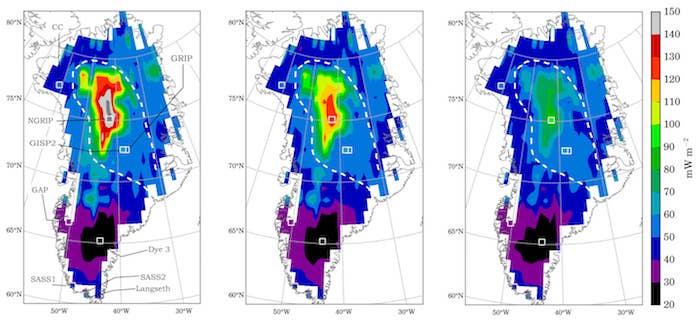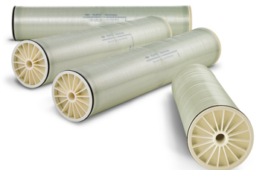
These are geothermal heat flux predictions for Greenland. Direct GHF measurements from the coastal rock cores, inferences from ice cores, and additional Gaussian-fit GHF data around ice core sites are used as training samples. Predictions are shown for three different values. The white dashed region roughly shows the extent of elevated heat flux and a possible trajectory of Greenland’s movement over the Icelandic plume. Credit: KU News Service
A new prediction model using machine learning forecasts a slightly elevated heat flux upstream of several fast-flowing glaciers in Greenland, including Jakobshavn Isbrae, the fastest moving glacier on Earth.
Researchers from the University of Kansas have used machine learning to develop an improved model for understanding geothermal heat flux—heat emanating from the Earth’s interior—below the Greenland Ice Sheet, which could lead to more accurate predictions for ice-mass loss and global sea-level rise.
“Heat that comes up from the interior of the Earth contributes to the amount of melt on the bottom of the ice sheet—so it’s extremely important to understand the pattern of that heat and how it’s distributed at the bottom of the ice sheet,” Soroush Rezvanbehbahani, a doctoral student in geology at the University of Kansas, said in a statement. “When we walk on a slope that’s wet, we’re more likely to slip.
“It’s the same idea with ice—when it isn’t frozen, it’s more likely to slide into the ocean,” he added. “But we don’t have an easy way to measure geothermal heat flux except for extremely expensive field campaigns that drill through the ice sheet. Instead of expensive field surveys, we try to do this through statistical methods.”
The team found that Greenland has an anomalously high heat flux in a relatively large northern region spreading from the interior to the east and west, while southern Greenland has a relatively low geothermal heat flux, corresponding with the extent of the North Atlantic Craton—a stable portion of one of the oldest extant continental crusts on Earth.
“The most interesting finding is the sharp contrast between the south and the north of Greenland,” Rezvanbehbahani said. “We had little information in the south, but we had three or four more cores in the northern part of the ice sheet.
“Based on the southern core we thought this was a localized low heat-flux region—but our model shows that a much larger part of the southern ice sheet has low heat flux,” he added. “By contrast, in the northern regions, we found large areas with high geothermal heat flux.
According to the research team, the new geothermal heat flux map of Greenland is expected to be within about 15 percent of true values.
The machine learning system uses all available geologic, tectonic and geothermal heat flux data for Greenland, as well as geothermal heat flux data from around the globe to predict geothermal heat flux values under the ice sheet throughout Greenland. It is based on 22 geologic variables, including bedrock topography, crustal thickness, magnetic anomalies, rock types, and proximity to features like trenches, ridges, young rifts, volcanoes and hot spots.
Current models do not incorporate as many data points to arrive at a prediction.
“Most other models really only honor one particular data set,” co-author Leigh Stearns, an associate professor of geology at KU, said in a statement. “They look at geothermal heat flux through seismic signals or magnetic data in Greenland, but not crustal thickness or rock type or distance from a hot spot.
“But we know those are related to geothermal heat flux,” she added. “We try to incorporate as many geologic data sets as we can rather than assuming one is the most important.”
The researchers found the five most important geologic features in predicting geothermal flux values are topography, distance to young rifts, distance to trench, depth of lithosphere-asthenosphere boundary (layers of the Earth’s mantle) and depth to Mohoroviči discontinuity (the boundary between the crust and the mantle in the Earth).
The study was published in Geophysical Research Letters.




